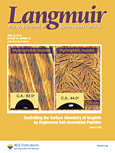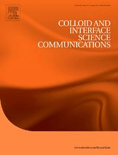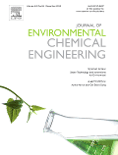
ADSORPTION SCIENCE & TECHNOLOGY
Scope & Guideline
Advancing Knowledge in Surface Science and Technology
Introduction
Aims and Scopes
- Research on Adsorbent Materials:
The journal publishes studies on the synthesis, characterization, and application of various adsorbent materials, including activated carbons, biochars, polymer composites, and nanomaterials, highlighting their effectiveness in removing pollutants from aqueous solutions. - Theoretical and Experimental Studies:
It includes both theoretical modeling and experimental investigations that explore adsorption kinetics, isotherms, and thermodynamics, providing a comprehensive understanding of adsorption mechanisms. - Environmental Remediation Applications:
A significant focus is placed on the application of adsorption technologies for environmental remediation, particularly the removal of heavy metals, dyes, and other contaminants from wastewater. - Innovative Techniques and Technologies:
The journal encourages submissions on innovative adsorption technologies, including advancements in machine learning, nanotechnology, and green chemistry for enhancing adsorption processes. - Sustainability and Resource Recovery:
There is a consistent emphasis on sustainable practices in adsorption technology, including the use of waste materials as adsorbents and the recovery of valuable resources from wastewater.
Trending and Emerging
- Machine Learning and AI in Adsorption Research:
There is a growing trend towards the integration of machine learning and artificial intelligence techniques in adsorption studies, facilitating predictive modeling and optimization of adsorption processes. - Sustainable and Green Adsorbents:
Research on sustainable adsorbents derived from biomass, waste materials, and eco-friendly synthesis methods is on the rise, reflecting a broader environmental consciousness within the field. - Application of Nanotechnology:
The use of nanomaterials and nanocomposites in adsorption processes has gained significant attention, with studies focusing on their enhanced properties and efficiencies compared to traditional adsorbents. - Focus on Emerging Contaminants:
There is an increasing emphasis on the removal of emerging pollutants, such as pharmaceuticals and personal care products, from wastewater, indicative of evolving environmental challenges. - Adsorption in Energy Applications:
Emerging research is exploring the role of adsorption in energy-related applications, including CO2 capture and energy storage, aligning with global sustainability goals.
Declining or Waning
- Focus on Traditional Adsorbents:
There seems to be a declining interest in traditional adsorbents such as silica gel and activated carbon from conventional sources, as researchers increasingly explore more sustainable and innovative materials. - Reduction in Studies on Fixed-Bed Column Studies:
Research involving fixed-bed column studies for adsorption processes has decreased, possibly due to the rise of more dynamic and computational approaches that offer greater insights into adsorption behavior. - Less Emphasis on Natural Adsorbents:
There has been a noticeable reduction in studies focusing on natural adsorbents derived from agricultural wastes, as the field shifts towards engineered materials with enhanced performance. - Decline in Theoretical Model Development:
Theoretical developments related to classical models of adsorption, such as Langmuir and Freundlich isotherms, appear to be less frequent, overshadowed by novel modeling approaches and machine learning applications.
Similar Journals

LANGMUIR
Unveiling Cutting-Edge Research in Materials and ElectrochemistryLANGMUIR is a prominent peer-reviewed journal published by the American Chemical Society, serving as a vital platform for research in various fields, including condensed matter physics, materials science, electrochemistry, and spectroscopy. With an ISSN of 0743-7463 and an E-ISSN of 1520-5827, this journal has established itself as a reputable source of cutting-edge scientific findings since its inception in 1985. Recognized for its rigorous academic standards, LANGMUIR holds significant ranking positions, including Q1 in condensed matter physics and spectroscopy, and Q2 categories in electrochemistry and materials science, reflecting its impactful contributions to these disciplines. Although the journal does not currently offer open access, it continues to foster collaboration and discussion among researchers by publishing high-quality articles that explore the frontiers of chemistry and physics. By engaging with LANGMUIR, readers can stay informed about the latest advances in surface and interface science, making it an essential resource for professionals, researchers, and students dedicated to these fields.

SEPARATION AND PURIFICATION TECHNOLOGY
Pioneering research in separation and purification technologies.SEPARATION AND PURIFICATION TECHNOLOGY is a leading multidisciplinary journal published by Elsevier, focused on advancing the fields of Analytical Chemistry and Filtration and Separation. With its ISSN 1383-5866 and E-ISSN 1873-3794, this prestigious journal has achieved remarkable recognition, ranking in the top quartile (Q1) in both its categories, reflecting its substantial impact and relevance in the scientific community. Operating from its headquarters in Amsterdam, Netherlands, SEPARATION AND PURIFICATION TECHNOLOGY serves as a vital platform for researchers, professionals, and students to disseminate innovative findings and methodologies related to separation processes and purification techniques. The journal not only promotes open access research but also maintains a rigorous peer-review process to ensure high-quality publications. With a convergence period spanning from 1997 to 2025, it highlights the ongoing evolution and importance of separation technology in various applications, establishing it as an essential resource for those interested in cutting-edge advancements in analytical and chemical engineering domains.

NEW CARBON MATERIALS
Leading the Charge in Carbon Material AdvancementsNEW CARBON MATERIALS, published by Elsevier, is a leading academic journal that focuses on the innovative and multidisciplinary field of carbon materials research. With an ISSN of 2097-1605 and an E-ISSN of 1872-5805, this journal has established itself as a prominent platform for disseminating cutting-edge studies and applications in the realm of carbon nanomaterials, composites, and their industrial applications. Recognized for its high quality, NEW CARBON MATERIALS holds a Q1 ranking in the Materials Science category, reflecting its significant impact within the scientific community. The journal has continuously fostered knowledge exchange since its inception in 2004 and is set to further advance research until 2024. With a Scopus rank of #89 out of 463 journals in the General Materials Science category, this publication is essential for researchers, professionals, and students seeking to stay informed about the latest developments in carbon materials. While it is not an open-access journal, it offers various access options to ensure that the latest findings are available to a broad audience. By bridging the gap between theory and practical application, NEW CARBON MATERIALS is at the forefront of addressing critical challenges and paving the way for future advancements in materials science.

Colloid and Interface Science Communications
Driving Innovation in Interface Science and Materials ChemistryColloid and Interface Science Communications is a prestigious peer-reviewed journal published by Elsevier, specializing in the vibrant fields of colloid and surface science, along with biotechnology. With an impressive open access policy initiated in 2022, this journal ensures wide dissemination of groundbreaking research. Its impact is reflected in its high standings within various Scopus category quartiles—ranked Q2 in Biotechnology and Colloid and Surface Chemistry, and Q1 in Materials Chemistry, Physical and Theoretical Chemistry, as well as Surfaces, Coatings and Films for 2023. Furthermore, it boasts exceptional Scopus rankings, including a top percentile position in several materials science categories, indicating its significant contribution to the scientific community. Published in the Netherlands, Colloid and Interface Science Communications aims to foster knowledge sharing and collaboration by providing a platform for innovators and researchers to explore cutting-edge developments in surface phenomena and materials interactions. As a key resource for researchers, professionals, and students alike, it plays a critical role in advancing our understanding and application of colloidal and interface science.

JOURNAL OF SURFACTANTS AND DETERGENTS
Fostering Multidisciplinary Collaboration in Chemical ResearchJournal of Surfactants and Detergents, published by Wiley, is a prominent peer-reviewed journal dedicated to advancing scientific knowledge in the field of surfactants, detergents, and their applications. With an ISSN of 1097-3958 and an E-ISSN of 1558-9293, this journal serves as an essential resource for researchers, industry professionals, and students specializing in Chemical Engineering, Physical and Theoretical Chemistry, and Materials Science. Since its inception in 1998, the journal has fostered innovative research and multidisciplinary collaboration, reflected in its current Q3 ranking in several Scopus categories. Although it operates under a traditional publishing model, the journal's robust research contributions continue to engage a wide audience eager to explore the latest developments in surfactant and detergent science. As a key player in the field, the journal not only publishes cutting-edge research but also facilitates dialogue and knowledge exchange, making it an invaluable asset for anyone invested in the chemistry of surfaces and interfaces.

Journal of Water Chemistry and Technology
Empowering Professionals with Insights in Water Treatment InnovationsThe Journal of Water Chemistry and Technology, published by PLEIADES PUBLISHING INC, serves as a critical resource for researchers and professionals dedicated to advancing the field of water science. With an ISSN of 1063-455X and an E-ISSN of 1934-936X, this journal focuses on the intersection of water chemistry and technology, addressing crucial issues related to water quality, treatment methods, and environmental sustainability. Despite coverage discontinuation in Scopus after 2017, the journal has contributed significantly to knowledge dissemination in the domains of Environmental Science and Chemistry, evidenced by its ranking among the top journals in its categories. Although it does not provide Open Access options, the journal maintains a commitment to publish high-quality research that informs best practices and innovative technologies in water treatment and management. Situated in the heart of New York, it continues to be a vital platform for academics, professionals, and students seeking to enhance their understanding of water chemistry and its technological applications.

Water Practice and Technology
Pioneering Research in Water Science and TechnologyWater Practice and Technology is a distinguished open-access journal published by IWA PUBLISHING, dedicated to disseminating cutting-edge research and practical insights within the field of water science and technology. With an E-ISSN of 1751-231X, the journal has been at the forefront of sharing knowledge since its inception in 2011 and has transitioned to open access in 2021, providing unrestricted access to high-quality research articles. Based in the United Kingdom, this journal plays a vital role in advancing the understanding of water resource management, treatment technologies, and environmental sustainability. As of 2023, it is categorized in the Q3 quartile for Water Science and Technology with a Scopus rank of #157/261, placing it in the 40th percentile among its peers. Researchers, professionals, and students alike will find the journal a valuable resource for the latest trends, innovations, and practical applications in the water sector, facilitating a collaborative approach towards addressing global water challenges.

PROGRESS IN REACTION KINETICS AND MECHANISM
Illuminating the Path of Reaction MechanismsProgress in Reaction Kinetics and Mechanism is a distinguished academic journal published by SAGE Publications Ltd, focusing on the intricate dynamics of reaction kinetics and mechanisms within the field of Physical and Theoretical Chemistry. With an ISSN of 1468-6783 and an E-ISSN of 1471-406X, this journal serves as a critical platform for researchers and practitioners seeking to explore and disseminate cutting-edge findings from 1999 to 2024. Although currently not categorized as Open Access, the journal maintains a competitive profile with a Q4 categorization in its field, showcasing its commitment to fostering scientific dialogue and inquiry. The journal ranks #140 out of 189 in its category, reflecting its integral role in advancing knowledge and understanding in chemistry. Scholars, professionals, and students who aim to stay at the forefront of research in reaction kinetics will find valuable insights and findings in this esteemed publication.

FULLERENES NANOTUBES AND CARBON NANOSTRUCTURES
Pioneering Discoveries in Nanomaterials ScienceFULLERENES NANOTUBES AND CARBON NANOSTRUCTURES, published by Taylor & Francis Inc, stands at the forefront of research in the fields of nanotechnology, materials science, and organic chemistry. With an ISSN of 1536-383X and an E-ISSN of 1536-4046, this journal offers a critical platform for disseminating significant findings related to carbon-based nanostructures, materials characterization, and their innovative applications. Recognized for its scholarly impact, the journal enjoys a Q2 ranking in several fields, including Atomic and Molecular Physics, Materials Science, and Organic Chemistry, reflecting its commitment to quality research. Since its inception in 2002, it has maintained a rigorous publication standard and provides open access options, enabling a diverse audience, from researchers to industry professionals, to engage with the latest advancements. The journal's comprehensive scope across converged years until 2024 emphasizes its pivotal role in fostering knowledge in the rapidly evolving realm of nanoscience and nanotechnology. Researchers and practitioners alike are encouraged to explore the cutting-edge research showcased in this vital resource.

Journal of Environmental Chemical Engineering
Leading the charge in environmental chemical innovation.Journal of Environmental Chemical Engineering, published by Elsevier in the United Kingdom, stands at the forefront of integrative research in the field of environmental science and engineering. With an impressive impact factor that places it in the top quartile (Q1) across multiple categories, including Chemical Engineering (Miscellaneous), Pollution, and Waste Management, it serves as a vital resource for researchers and professionals dedicated to advancing sustainable chemical processes and technologies. Since its inception in 2013, this journal has continually focused on fostering innovation and disseminating knowledge that addresses global environmental challenges. With rankings that highlight its influence—22nd in Environmental Science & Pollution and 11th in Process Chemistry & Technology—the journal publishes high-quality articles that span both theoretical investigations and applied research. This dedication to excellence culminates in a comprehensive platform that not only shares significant advancements but also shapes the future directions of environmental chemical engineering.